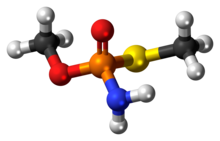Methamidophos, trade name "Monitor," is an organophosphate insecticide.

| |

| |
| Names | |
|---|---|
| Preferred IUPAC name
O,S-Dimethyl phosphoramidothioate | |
| Identifiers | |
3D model (JSmol) |
|
| 1098870 | |
| ChEBI | |
| ChEMBL | |
| ChemSpider |
|
| ECHA InfoCard | 100.030.538 |
| EC Number |
|
| KEGG |
|
PubChem CID |
|
| RTECS number |
|
| UNII | |
| UN number | 3018 2783 |
CompTox Dashboard (EPA) |
|
| |
| |
| Properties | |
| C2H8NO2PS | |
| Molar mass | 141.1 g/mol |
| Density | 1.31 g/cm3 |
| Melting point | 44.5 °C (112.1 °F; 317.6 K) |
| Boiling point | thermally unstable |
| Hazards | |
| GHS labelling: | |
 
| |
| Danger | |
| H300, H311, H330, H400 | |
| P260, P264, P270, P271, P273, P280, P284, P301+P310, P302+P352, P304+P340, P310, P312, P320, P321, P322, P330, P361, P363, P391, P403+P233, P405, P501 | |
Except where otherwise noted, data are given for materials in their standard state (at 25 °C [77 °F], 100 kPa). | |
Crops grown with the use of methamidophos include potatoes[1] and some Latin American rice.[2] Many nations have used methamidophos on crops, including developed nations such as Spain, United States, Japan, and Australia. Due to its toxicity, the use of pesticides that contain methamidophos is currently being phased out in Brazil. In 2009, all uses in the United States were voluntarily canceled.[3]
LD50 rates of 21 and 16 mg/kg for male and female rats, respectively. 10–30 mg/kg in rabbits, and dermal LD50 of 50 mg/kg in rats. It is rapidly absorbed through the stomach, lungs, and skin in humans, and eliminated primarily through urine.[4] It is a cholinesterase inhibitor.
Breakdown in soil is 6.1 days in sand, 309 days in water at pH 5.0, 27 days at pH 7.0, and 3 days at pH 9.0. Sunlight accelerates breakdown. It is uptaken through roots and leaves of plants.[4]
It is classified as a WHO Toxicity Class "Class 1b, Highly Hazardous", and its parent chemical, acephate, is "class III, Slightly Hazardous".
Methamidophos is used in great quantities in ricefields in China.[5] Rice–fish culture is common in the southern parts of China as well as in many other rice-producing countries (e.g., Thailand, Malaysia, and the Philippines). Brown rice (unpolished) in this study contained double the concentration of polished rice. Both plants and animals did not degrade the pesticide well, and fish for human consumption in these cases contains methamidophos in concentrations roughly similar to brown rice.[5]
Methamidophos was found in dumplings (gyoza) manufactured in China for the Japanese market after a number of consumers became sick.[6]